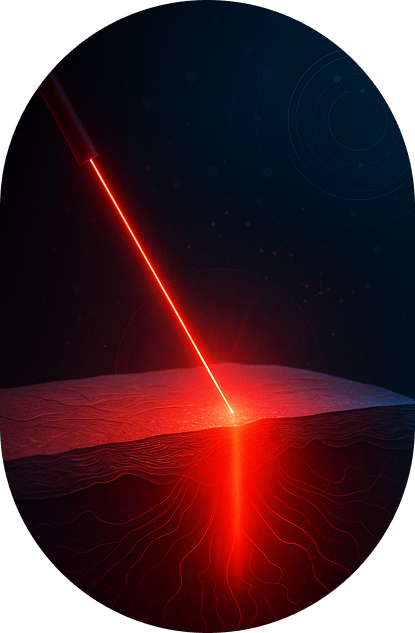PHOTOBIOMODULATION / BENEFITS
Photobiomodulation Benefits
Ready to Feel, Think, Perform, and Look Better?

HISTORY
Photobiomodulation was discovered in 1967 by Endre Mester at the Semmelweis Medical University in Hungary. Mester was attempting to replicate an experiment to treat rats with implanted tumors, but instead, he observed a heightened rate of hair growth and improved wound healing using a low-power laser beam. This was the first indication that low-level laser light, now referred to as Photobiomodulation, could have its beneficial applications in medicine. This discovery led to what we now call “Photobiomodulation Therapy (PBMt).”[1] Since then, multiple research studies have been conducted, demonstrating the benefits of Photobiomodulation in reducing pain and inflammation associated with various orthopedic conditions, including neck pain, tendonitis, and carpal tunnel syndrome, as well as enhancing wound healing and other health applications.
- 01 Feel Better
- 02 Think Better
- 03 Perform Better
- 04 Look Better
Feel Better
Wellness Benefits: Researchers call the benefits of photobiomodulation “too good to be true.” A reduction in pain and inflammation associated with various autoimmune conditions, such as neuropathy, arthritis, and fibromyalgia, as well as injuries and surgeries, presents the first level of benefit for individuals who report feeling better with full-body LED Light Therapy.
Regents Center’s owner, John Molenhouer, and his C-level clients utilize his ATP LED therapy beds to recharge their batteries midday, which is an extraordinary benefit of full-body LED Light Therapy. How many who hit the wall midday could use a tool to rejuvenate the body and mind? Imagine having a light therapy bed available to your employees.
The ARRC LED ATP, ATP RF, and Elysium LED Light Therapy beds precisely meter out the optimum dose of light and frequencies serving the body with the perfect amount of energy to penetrate deep into the muscles and joints without over-delivering.

Think Better
Researchers and practitioners worldwide recognize that LED Light Therapy, particularly near-infrared light, can penetrate the brain and provide benefits. The benefits that LED Light Therapy presents, including restoring nerve cell function and rebuilding damaged nerves (Neurogenesis), combined with the infusion of energy into the mitochondria, improved circulation, and reduced inflammation throughout the brain, are substantial.[2] Add the correct pulse, and researchers are showing that frequencies can break apart the amyloid plaques that precede Alzheimer’s Disease.
Dr. Lew Lim of Vielight has conducted remarkable research using 810nm near-infrared LED Light to aid patients with Alzheimer’s, Dementia, and TBI in their recovery. His telling statement includes being able to interview patients who were unable to speak.
Full Body LED Light Therapy creates a systemic benefit to “nearly every tissue, organ, and system in the body”. As Dr. Mercola suggested in his interviews, near-infrared light will be an extraordinary mechanism to fight the “tsunami of Alzheimer’s and Dementia” that will plague the US as baby boomers move into their later years.

Perform Better
The ARRC LED ATP Full-Body LED Light Therapy system is utilized by the NCAA, the NFL, Premier Soccer, UFC Athletes, the US Military, and numerous individuals to aid in accelerating recovery from injury and competition, as well as to enhance performance before competition.
Full Body LED Light Therapy creates a systemic reduction in inflammation, reducing pain and improving recovery time. Peer-reviewed research shows that LED Light Therapy in the right wavelengths and dose can help athletes in 4 powerful ways:[3]
- Increase single rep max (strength)
- Increase total reps prior to failure (endurance)
- Increase total reps in a given time (speed)
- Protect the body against the mechanical damage that happens during competition.
If doctors who conduct research for the US Military recommend the ARRC LED ATP system, we believe you’ll also appreciate the ATP system.

Look Better
“I’ve been working with LED Light Therapy since 2007 as a tool in the aesthetics industry to help reduce wrinkles. What I heard from our facial panel system owners is what propelled me to start the ARRC LED. The number one comment was “Do you know what this machine is doing now?” This is what owners would tell me that went above and beyond the typical comments like ‘My skin has never looked better,’ ‘My Eyelashes look like they did in high school,’ ‘My clients are loving what this is doing for their hair’ and ‘This was the only thing to get rid of adult acne’ They bought these expensive facial panels to help their client’s skin but used them on other parts of the body, and it worked for all kinds of ailments.
That is when I set out to build a full-body LED Light Therapy Bed.”
Mike McIntyre,
CEO ARRC LED.
Countless published and peer-reviewed studies demonstrate the effectiveness of LED Light Therapy in enhancing collagen production and tightening the elastin layer.[4] Greenlight was well known for its ability to increase blood flow in the skin, helping to reduce hyperpigmentation.

Photobiomodulation Benefits For The Brain
The benefits of PBM therapy result from the stimulation of the mitochondrial electron transport chain. When Photobiomodulation is applied at optimal wavelengths and dosages, studies show it may lead to therapeutic effects in the target organs without causing adverse effects. Photobiomodulation Therapy (PBMt) may also help increase cerebral blood flow by increasing brain energy metabolism and increasing antioxidant defenses.[5] Another proposed benefit is the ability to promote the protection and survival of neurons. In addition to these potential therapeutic effects, there is growing evidence of beneficial behavioral changes, including cognitive improvements, antidepressant effects, and enhanced sleep quality. “Many investigators believe that PBM for brain disorders will become one of the most important medical applications of light therapy in the coming years and decades.”[6]
Photobiomodulation benefits in sports
Photobiomodulation Therapy (PBMt) involves the use of low-level light to modulate cellular activity and improve the biological function of tissues and cells. It works by activating mitochondria so that the flow of photons causes several physiological changes, such as increasing Adenosine Triphosphate (ATP) production. On average, muscle tissue contains more mitochondria than other body tissue or organ tissue, when compared at a cellular unit. This is why muscle tissue reacts faster to Photobiomodulation because muscle requires more ATP. Photobiomodulation Therapy benefits sports performance by producing powerful energy during exercise and increasing post-exercise recovery speed. Multiple clinical trials show that muscle enhancement, fat loss, and increased endurance is closely related to the amount of ATP production.
Several studies have shown that the benefits of Photobiomodulation may be cell proliferation, metabolism stimulation, inflammation reduction, and tissue healing. The dose delivered to a particular tissue type is crucial among the parameters used, as the effects will depend on it. While low dose administration may lead to a significant cellular response, high doses can inhibit cell proliferation and even induce apoptosis.
Photobiomodulation benefits for the neurological system
Photobiomodulation uses visible light with wavelengths typically 450 to 700 nm and infrared at wavelengths 800 to 1000 nm at low power densities to minimize possible tissue damage. Photons can cause chemical changes in cells and provoke various neuroprotective reactions, showing improvement in blood flow and causing metabolic changes and neurogenesis. Many studies have demonstrated the possible therapeutic effects on neurological diseases, peripheral nerve injuries, pain relief, and wound healing.
Other Photobiomodulation benefits with Alzheimer’s Disease, Parkinson’s and Anxiety
There is an epidemic of AD that is expected to hit the Western world as the overall population ages. Although the evidence for the effectiveness of PBMt in the treatment of AD is still very preliminary, it is possible that PBM will play an even larger role in society in the years to come. In one study, Alzheimer’s patients had significant improvements in memory and other cognitive skills after 12 weeks. These patients also reported better sleep, fewer outbursts of anger, and less anxiety. In addition a clinical study showed improved balance, speech, and cognitive function in Parkinson’s patients.
There are also several studies looking at the benefits of Photobiomodulation Therapy (PBMt) on anxiety and depression. A survey conducted in 2016 applied light therapy to the foreheads of patients with anxiety and depression. They found improvements in depression and anxiety after a single treatment that lasted at least two weeks.
Frequently Asked Questions About Photobiomodulation Benefits
[1][12][14]Dompe, C., Moncrieff, L., Matys, J., Grzech-Leśniak, K., Kocherova, I., Bryja, A., Bruska, M., Dominiak, M., Mozdziak, P., Skiba, T. H. I., Shibli, J. A., Angelova Volponi, A., Kempisty, B., & Dyszkiewicz-Konwińska, M. (2020, June 3). Photobiomodulation-underlying mechanism and clinical applications. Journal of clinical medicine. https://pmc.ncbi.nlm.nih.gov/articles/PMC7356229/
[2][6]Hamblin, M. R. (2016, October 1). Shining light on the head: Photobiomodulation for brain disorders. BBA clinical. https://www.ncbi.nlm.nih.gov/pmc/articles/PMC5066074/
[3][7]Ailioaie, L. M., & Litscher, G. (2021, December 3). Photobiomodulation and sports: Results of a narrative review. Life (Basel, Switzerland). https://pmc.ncbi.nlm.nih.gov/articles/PMC8706093/
[4]Li WH;Seo I;Kim B;Fassih A;Southall MD;Parsa R; (n.d.). Low-level red plus near infrared lights combination induces expressions of collagen and elastin in human skin in vitro. International journal of cosmetic science. https://pubmed.ncbi.nlm.nih.gov/33594706/
[5]Salehpour, F., Mahmoudi, J., Kamari, F., Sadigh-Eteghad, S., Rasta, S. H., & Hamblin, M. R. (2018, August). Brain Photobiomodulation therapy: A narrative review. Molecular neurobiology. https://pmc.ncbi.nlm.nih.gov/articles/PMC6041198/
[8]Yang, M., Yang, Z., Wang, P., & Sun, Z. (2021, June). Current application and future directions of photobiomodulation in central nervous diseases. Neural regeneration research. https://pmc.ncbi.nlm.nih.gov/articles/PMC8224127/
[9]Hanford, N., & Figueiro, M. (2013). Light therapy and alzheimer’s disease and related dementia: Past, present, and future. Journal of Alzheimer’s disease : JAD. https://pmc.ncbi.nlm.nih.gov/articles/PMC3553247/
[10]Rutten, S., Vriend, C., van den Heuvel, O. A., Smit, J. H., Berendse, H. W., & van der Werf, Y. D. (2012). Bright light therapy in parkinson’s disease: An overview of the background and evidence. Parkinson’s disease. https://pmc.ncbi.nlm.nih.gov/articles/PMC3540893
[11]Maiello, M., Losiewicz, O. M., Bui, E., Spera, V., Hamblin, M. R., Marques, L., & Cassano, P. (2019, October). Transcranial photobiomodulation with near-infrared light for generalized anxiety disorder: A pilot study. Photobiomodulation, photomedicine, and laser surgery. https://pmc.ncbi.nlm.nih.gov/articles/PMC6818480
[13]Maghfour J;Ozog DM;Mineroff J;Jagdeo J;Kohli I;Lim HW; (n.d.-a). Photobiomodulation CME Part I: Overview and mechanism of action. Journal of the American Academy of Dermatology. https://pubmed.ncbi.nlm.nih.gov/38309304/
What Is Photobiomodulation Good for?
Photobiomodulation (PBM), also known as low-level laser therapy (LLLT), is suitable for many health benefits and can help the body produce new cells and enhance stem cell contrast.
What Are the Results of Photobiomodulation Therapy?
Our studies show (and systematic reviews linked above support) the following potential results of low-level light therapy interventions:
- Reduced pain and anti-inflammatory benefits help you feel better
- Cognitive benefits like brain circulation and enhanced mitochondrial energy, so that you can think more clearly
- Improved muscular endurance and strength to perform and recover better
- Improves collagen and elastin production, reduces wrinkles, and aids the wound healing process to help you look better than ever
- Enhanced neurological and systemic benefits like neurogenesis, neuroprotection, and healing nerve injuries
- Improved mental health with support for depression, anxiety, and Alzheimer’s
The benefits of photobiomodulation therapy may vary from individual to individual. The best way to know for sure is to leverage the best device on the market for your optimal wellness.
How Long Does Photobiomodulation Take to Work?
Results will vary depending on what you’re targeting, the dose received, and the frequency of treatment, paired with other recovery efforts. Consistency is paramount with any light or energy medicine. One session will not yield significant or lasting results. Three to five sessions a week are recommended for many cases. With consistent treatment, some patients achieve the desired results within a few weeks or months, depending on the individual.
Who Can Benefit from PBM Therapy?
Anyone who is wellness-minded, someone looking for non-invasive solutions for tissue repair, Parkinson’s disease patients, Alzheimer’s patients, those who suffer from a traumatic brain injury (TBI), anyone struggling with mental health conditions like anxiety, depression, stress, or others, those with immune system dysfunction, and more. [12]
What Is the Ideal Wavelength for Brain Photobiomodulation?
Red light therapy involves 2–4 wavelengths from 620 to 700 nm, which are absorbed by cytochrome c oxidase (CCO) in the mitochondria.[13] However, it isn’t as effective as the ARRC LED method, which expands the wavelengths to increase the phase angle. RLT augments doses with frequency, phase angle, and power, and imprints information patterns. The ARRC LED method is how we create a system that patients can actually feel— A system dramatically beyond red light therapy, into an entirely new class of device.
Are There Any Side Effects of Photobiomodulation Therapy?
Most ARRC LED patients experience no side effects, especially when using PBMt for pain relief, which is in stark contrast to other pain management strategies, like opioids. Some mild side effects may include skin irritation, itching, and redness; however, these are generally minimal and may not occur in all individuals.[14]
[1][12][14]Dompe, C., Moncrieff, L., Matys, J., Grzech-Leśniak, K., Kocherova, I., Bryja, A., Bruska, M., Dominiak, M., Mozdziak, P., Skiba, T. H. I., Shibli, J. A., Angelova Volponi, A., Kempisty, B., & Dyszkiewicz-Konwińska, M. (2020, June 3). Photobiomodulation-underlying mechanism and clinical applications. Journal of clinical medicine. https://pmc.ncbi.nlm.nih.gov/articles/PMC7356229/
[2][6]Hamblin, M. R. (2016, October 1). Shining light on the head: Photobiomodulation for brain disorders. BBA clinical. https://www.ncbi.nlm.nih.gov/pmc/articles/PMC5066074/
[3][7]Ailioaie, L. M., & Litscher, G. (2021, December 3). Photobiomodulation and sports: Results of a narrative review. Life (Basel, Switzerland). https://pmc.ncbi.nlm.nih.gov/articles/PMC8706093/
[4]Li WH;Seo I;Kim B;Fassih A;Southall MD;Parsa R; (n.d.). Low-level red plus near infrared lights combination induces expressions of collagen and elastin in human skin in vitro. International journal of cosmetic science. https://pubmed.ncbi.nlm.nih.gov/33594706/
[5]Salehpour, F., Mahmoudi, J., Kamari, F., Sadigh-Eteghad, S., Rasta, S. H., & Hamblin, M. R. (2018, August). Brain Photobiomodulation therapy: A narrative review. Molecular neurobiology. https://pmc.ncbi.nlm.nih.gov/articles/PMC6041198/
[8]Yang, M., Yang, Z., Wang, P., & Sun, Z. (2021, June). Current application and future directions of photobiomodulation in central nervous diseases. Neural regeneration research. https://pmc.ncbi.nlm.nih.gov/articles/PMC8224127/
[9]Hanford, N., & Figueiro, M. (2013). Light therapy and alzheimer’s disease and related dementia: Past, present, and future. Journal of Alzheimer’s disease : JAD. https://pmc.ncbi.nlm.nih.gov/articles/PMC3553247/
[10]Rutten, S., Vriend, C., van den Heuvel, O. A., Smit, J. H., Berendse, H. W., & van der Werf, Y. D. (2012). Bright light therapy in parkinson’s disease: An overview of the background and evidence. Parkinson’s disease. https://pmc.ncbi.nlm.nih.gov/articles/PMC3540893
[11]Maiello, M., Losiewicz, O. M., Bui, E., Spera, V., Hamblin, M. R., Marques, L., & Cassano, P. (2019, October). Transcranial photobiomodulation with near-infrared light for generalized anxiety disorder: A pilot study. Photobiomodulation, photomedicine, and laser surgery. https://pmc.ncbi.nlm.nih.gov/articles/PMC6818480
[13]Maghfour J;Ozog DM;Mineroff J;Jagdeo J;Kohli I;Lim HW; (n.d.-a). Photobiomodulation CME Part I: Overview and mechanism of action. Journal of the American Academy of Dermatology. https://pubmed.ncbi.nlm.nih.gov/38309304/